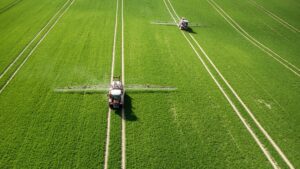Color the Seeds But Stay Inside the Lines
Imagine you’re playing a game and doing your best to understand and play by the complex rules, but then another player enters who has made no effort to do the same. How do you stay in the game, especially when the rules are getting stricter all the time?
It’s tough, but the right teammate can make all the difference.
This is the reality seed treatment ingredient companies live in every day. And when products are marketed globally, it only increases the complexity of trying to adjust to changing regulations. There’s value when companies can stay up to date with changes coming down the pike.
“Inert ingredients in seed treatments have received a lot of attention over the past 10 years as they’ve started requiring more testing and are being required to meet higher standards,” says Vice President of Technology for Standard Colors John Kibbee, North American partner with Clariant. “Ultimately we want to manage anything we put on the seed with the utmost respect.”
It’s more than just following the minimum requirements for compliance, too. For Agrocer® brand colorants, coatings and polymers, it’s going above and beyond. This means the company pays attention to evolving issues and regulations and works proactively on formulation changes. As a result, they provide companies with products that meet unique specs of the various global regulatory bodies.
Understand Complex Regulations
Seed and seed treatments are the beginning of the food chain and have impact in so many ways – such as the environment and ultimately our food – so it’s important to have standards based on science and testing.
“We reduce risk and potential supply disruptions when we carry safety standards through from active ingredients, to inert ingredients,” Kibbee says. “Well established rules and regulations give us a measure by which we can prove, with science, what we’re putting on the seed and in the environment is thoroughly tested.”
“Regulation actually spurred innovation and modernization of the industry,” he continues. “Pigments Agrocer Red 112 and Agrocer Yellow 001 were the first of those innovations by Clariant.”
Each of Agrocer’s line of colorants and seed treatment additives meet the requirements found in the Codes of Regulations (CFR) 40, part 180 regarding exemptions to tolerances of chemical residues in food and feed. 40 CFR requires the customer to seek clarity before using any seed treatment or coating product, as this statute has two categories, both food and non-food. Please refer to the Code of Federal Regulations for appropriate use. Food and feed crop use fall under various sections of part 180.
It’s very important to ask about details of any seed treatment supplier company’s compliance with CFR 40, such as whether the product is approved for food‑use (for food and feed crops), or nonfood‑use, which are two broad categories of the regulations. The nonfood-use applies to something that will never be food such as ornamental plants, highway rights-of-way and rodent control. The ingredients must fall into the food‑use category for treating crops like soybeans, wheat and corn.
For example, seed coating products for non-food crops can contain ingredients which according to CFR 40 can be used for turf grass or other non-edible crops, but not for food crops. It is important to know what ingredients are in your coating product use.
All Agrocer product ingredients qualify for both food- and nonfood-use. We keep it simple: our products can be used for all crops.
“Safe, healthy and nutritious food begins with the seed, and these guidelines are in place to ensure such,” says Standard Colors Vice President of Marketing and Business Development Kevin Brost. “We pride ourselves in working closely with ingredients that meet or exceed 40 CFR part 180 requirements.”
Predict Regulatory Changes
Regulations are reviewed and assessed, after which various global regulatory agencies update the criteria by which ingredients must follow. It can be tricky in a single country, so tracking global changes is no small ask.
“Many of our customers use these products around the world, so we stay in-tune with global regulations,” Brost says. “We do this by paying attention to regulatory trends, tracking global regulatory proposals and keeping an ear to the ground on issues that could impact our industry.”
“Another change we’re watching is in the European Union,” Kibbee says. “We’re working on removing tristyrylphenols and microplastics from our products in response to emerging EU concerns.”
Because changing formulations doesn’t happen overnight, Clariant is working to adhere to regulations that haven’t been changed yet. Now, when and if such changes are made, the company will be able to offer such products to our customers and allow them to be prepared for adjustments ahead of the regulation.
“Regulations are a valuable part of our industry,” says Mark Self, Clariant market segment manager-special applications. “The next time you are considering what to put on your seed, think about what is behind those ingredients, and how their application fits with 40 CFR part 180. Clariant prides itself in making our products compliant around the globe because better ingredients yield a better crop”.
To learn more, visit www.clariant.com/agrocer or contact Kevin Brost at 406-204-4404 or kevin.brost@standardcolors.com











